


Lesson Objective: Heredity is defined as the passing of physical or mental traits genetically from parents to offspring, and scholars learn that genes store our hereditary information (scholars do not know where genes are located or how they obtain our hereditary information yet). They think about the Essential Question and what they might have in common with their friends and family members.
Materials Needed
Prep
What are scholars doing in this lesson?
Do Now
Launch
Activity Activity and materials from Traits Bingo by Genetic Science Learning Center © 2008 University of Utah
[Engagement Tip: Choose scholars to pick one question at a time from the bag and read it to the class.]
[Tip: If one scholar gets a “bingo” early on, continue playing with a new goal (e.g., two “bingos” on one card) to allow the game to continue.]
Discourse Debrief activity:
Introduce the Essential Question:
[Parent Investment Tip: Tell scholars to go home and ask their family members about some of the common inherited traits in their family!]
Accountability (Exit Ticket) Note: Do not coach scholars during this Exit Ticket. Instead, allow them to try to answer the Essential Question using their own prior knowledge.
I think we inherit traits by getting some of our parents’ DNA when we are first created. I think that when a sperm and egg combine, they give some of each parent’s traits to the future offspring. For example, maybe the sperm has the eye color trait and the egg has the hair color trait. When the baby is born, he or she already has the traits from each parent in its DNA (even if they don’t show yet).
Scoring Award points as follows:
Lesson Objective: Mitosis and meiosis are forms of cell division that differ in both process and product. Meiosis produces the gametes that will ultimately create genetically varied offspring.
Materials Needed
Prep
What are scholars doing in this lesson?
Do Now
Launch
Research
[Parent Investment Tip: Display scholar models for the rest of the unit, then send them home to families!]
Discourse Debrief activity:
Make connections to the Essential Question:
Accountability (Exit Ticket)
If a mouse’s cells stopped dividing after it was born, it wouldn’t be able to grow any larger. One reason that cells divide is to create new cells. Because organisms are made out of cells, growing larger requires new cells to be created. New somatic (body) cells are created during cell division through a process called mitosis.
Scoring Award points as follows:
Do Now
Launch
Research
[Tip: Play each video twice or make them available for scholars to replay at their tables.]
[Tip: Allow scholars to access the Cell Division: Mitosis and Meiosis activity link from the previous lesson to gather additional information.]
Discourse Debrief activity:
Make connections to the Essential Question:
Make broader connections:
[Parent Investment Tip: Encourage scholars to go home and ask their family members if they know the difference between mitosis and meiosis!]
Accountability (Exit Ticket)
Scoring Award points as follows:
Lesson Objective: Chromosomes contain genes, which contain our DNA. Scholars can identify the relationships between sexual reproduction and meiosis and asexual reproduction and mitosis. They also understand why sexual reproduction leads to a combination of traits in each offspring, whereas asexual reproduction creates exact genetic copies.
Materials Needed
Prep
What are scholars doing in this lesson?
Do Now
Launch
Research
[Tip: Provide scholars with effective strategies for note-taking to draw meaning from the video.]
Discourse Debrief activity:
Make connections to the Essential Question:
Accountability (Exit Ticket)
Sexual and asexual reproduction differ in both process and product.
I agree with this statement. Sexual and asexual reproduction do differ in process, because sexual reproduction requires two parents, whereas asexual reproduction only requires one. Additionally, they differ in product because sexual reproduction results in genetically unique offspring, whereas asexual reproduction results in offspring that are genetically identical to their parent.
Scoring Award points as follows:
Lesson Objective: An equal number of traits are passed down from each parent, and an individual’s overall combination of traits makes them unique. Every somatic cell within an organism contains the same exact set of chromosomes.
Materials Needed
Prep

Image credit: Module: The Basics and Beyond: An Introduction to Heredity, Generation of Traits by Genetic Science Learning Center © 2006 University of Utah
What are scholars doing in this lesson?
Do Now
Launch
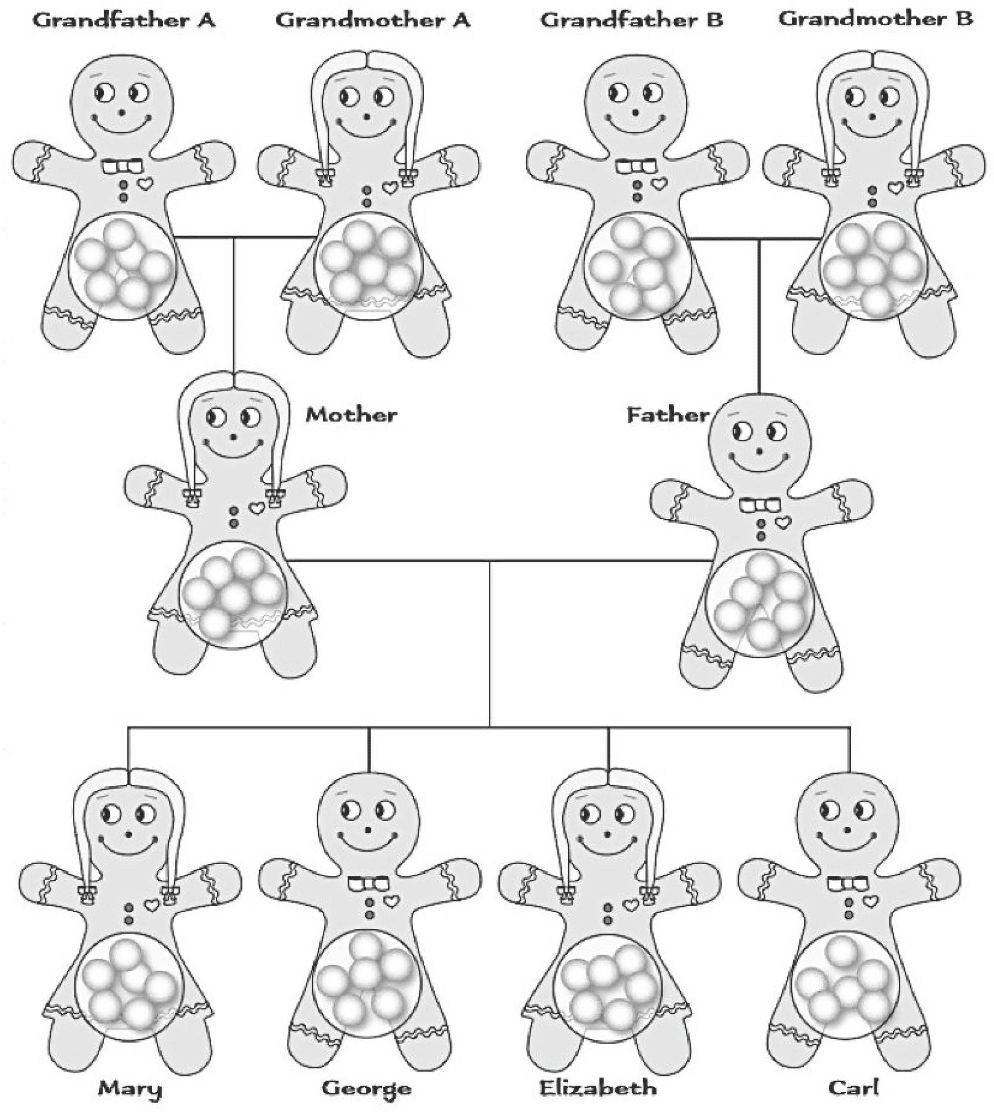
Image credit: Module: The Basics and Beyond: An Introduction to Heredity, Generation of Traits by Genetic Science Learning Center © 2006 University of Utah
Activity Adapted from Module: The Basics and Beyond: An Introduction to Heredity, Generation of Traits by Genetic Science Learning Center © 2006 University of Utah

Image credit: Module: The Basics and Beyond: An Introduction to Heredity, Generation of Traits by Genetic Science Learning Center © 2006 University of Utah
Discourse Debrief activity:
Make connections to the Essential Question:
Accountability (Exit Ticket) Two scholars are having a debate in science class.
Max says, “Sexual reproduction really increases genetic diversity in a population!” Peter replies, “No, Max! It’s asexual reproduction that increases genetic diversity!”
I agree with Max, because sexual reproduction contributes to a species’ genetic diversity by creating new combinations of inherited traits. Each offspring inherits traits from both parents, and the results are different for every organism, leading to a variety of unique living things. Genetic diversity is evident even among a group of siblings they are bound to have many traits in common, but each has several unique characteristics as well.
Scoring Award points as follows:
Lesson Objective: An allele is one of the two or more forms of a gene present in a population. Within an individual organism, a gene may be homozygous (having two identical alleles on a pair of chromosomes) or heterozygous (having two different alleles on a pair of chromosomes). Not all traits are expressed some traits are dominant over others and can be expressed while another recessive trait is carried but does not show outwardly. This is the reason why an organism’s genotype and phenotype are different.
Materials Needed
Prep
What are scholars doing in this lesson?
Do Now
Launch
Activity
[Materials Management Tip: Scholars should immediately reseal each pea pod after use. This will allow multiple classes to reuse materials.]
Discourse Debrief activity:
Make connections to the Essential Question:
Accountability (Exit Ticket) Louisa and Ray decide to have a baby. Louisa has brown eyes, and Ray has blue eyes.
The baby’s eye color will be determined by the allele each parent donates for that trait. Each parent has two alleles for eye color, and one will be donated to the baby. Because some alleles are dominant and others are recessive, the baby’s eyes will match the dominant allele it receives.
Note: This response is scientifically accurate but incomplete. At this point in the unit, this is expected scholars can only apply the understanding they have so far!
Scoring Award points as follows:
Lesson Objective: Punnett squares are used to calculate the probability of inheritance of certain traits among offspring. Scholars should feel comfortable both using and analyzing the results of a Punnett square.
Materials Needed
Prep
What are scholars doing in this lesson?
Do Now
Launch
Activity
Discourse Debrief activity:
[Engagement Tip: Allow scholars who were successful to lead this portion.]
[Tip: These are abstract concepts that scholars will delve into more deeply during high school. For now, simply reinforce the idea that DNA located on chromosomes, which are inside the nucleus of a cell carries the genetic information.]
Make connections to the Essential Question:
Accountability (Exit Ticket) A scientist has some red-eyed fruit flies. She knows that red eyes are dominant over white eyes in fruit flies. She is studying the fruit flies and wants to find out if they are homozygous or heterozygous for eye color.
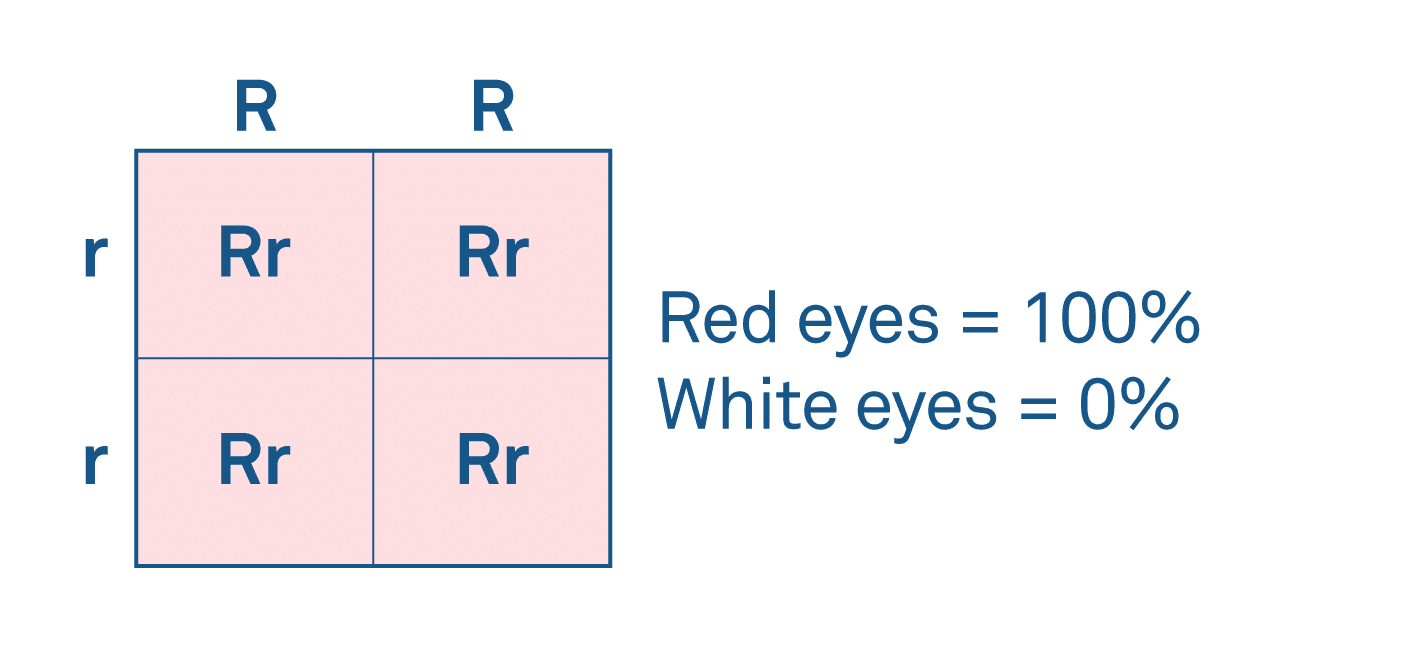 If the red-eyed fruit flies are homozygous, they will always donate an allele for red eyes (R) to every offspring. Because R is dominant, all offspring will end up with red eyes, because the allele for red eyes will be dominant over the allele for white eyes.
If the red-eyed fruit flies are homozygous, they will always donate an allele for red eyes (R) to every offspring. Because R is dominant, all offspring will end up with red eyes, because the allele for red eyes will be dominant over the allele for white eyes.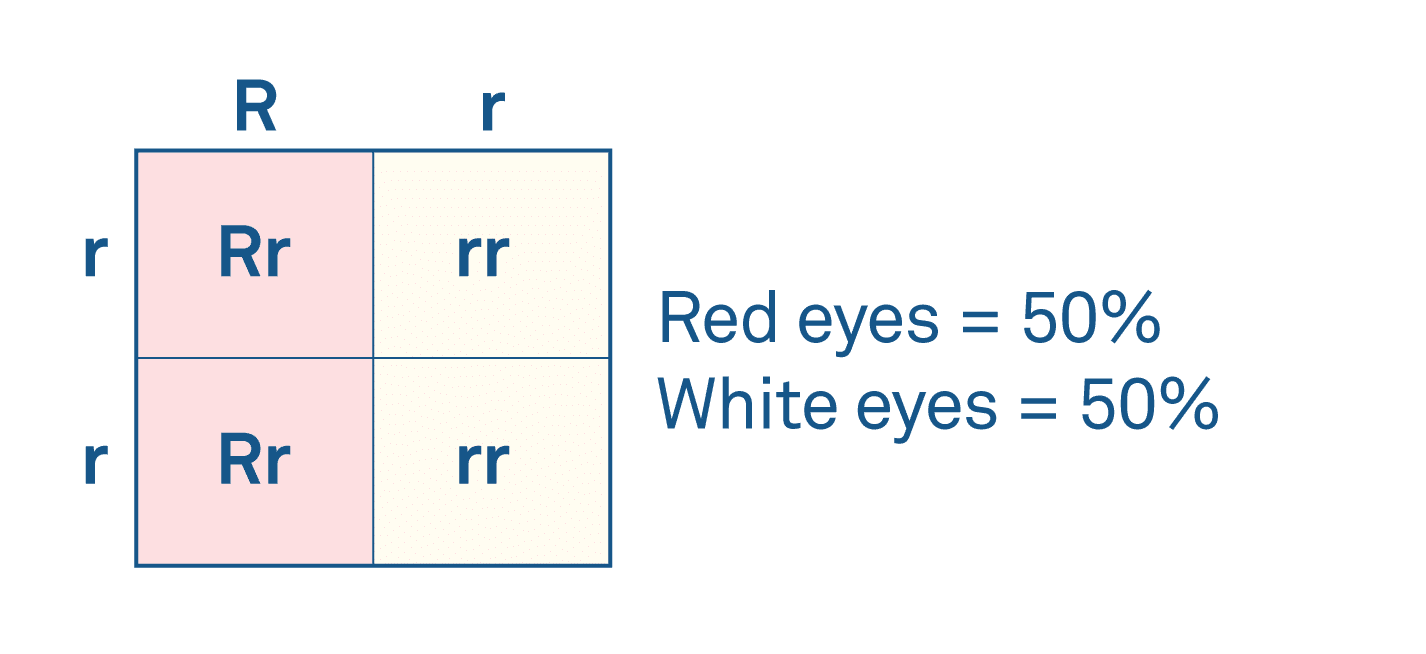
Scoring Award points as follows:
Lesson Objective: Not all patterns of inheritance follow the simple rules of Mendelian genetics. Instead, other forms of gene expression exist, such as codominance and incomplete dominance.
Materials Needed
Prep
What are scholars doing in this lesson?
Do Now
Launch
Activity Adapted from Alabama Learning Exchange’s “Dragon Genetics” activity
[Tip: Scholars are usually surprised at the variety of siblings. Point out that only a few traits are considered in this activity; with more traits, there would be even more diversity!]
[Parent Investment Tip: Encourage scholars to take their dragons home and explain their work to their parents!]
Discourse Debrief activity:
Make connections to the Essential Question:
Accountability (Exit Ticket) The top row in the picture below shows two different plants with different genes for flower color (pure red and pure white). The plants on the bottom are the result of breeding one pure red-flowered plant with one pure white-flowered plant. Use the picture to answer the question that follows.
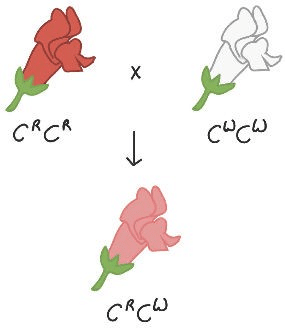
Image credit: Khan Academy
1. Does the offsprings’ flower color best represent a Mendelian pattern of inheritance, codominance, or incomplete dominance? Explain your response using evidence from the picture. [2]
This offspring’s flower color is an example of incomplete dominance. Incomplete dominance occurs when one allele does not completely dominate another and a new phenotype is created. Here, you can see that the two traits (red flowers and white flowers) are blended into a new phenotype: pink flowers.
The two cows pictured below each carry a dominant trait for coat color: one for a black coat (BB) and one for a white coat (WW). Use the picture to answer the question that follows.
2.If a pure black male cow and a pure white female cow mated, what might their offspring’s coat look like? Shade in the picture below using your pencil to show one possible phenotype for the baby cow. [1]
Exemplar:
Scoring Award points as follows:
2.Award one point for shading in the baby cow to show that the black and white fur are codominant.
Note: The pattern/distribution does not need to be a realistic cow pattern stripes, for example, may be awarded full credit.
Lesson Objective: Pedigree charts support scientists in analyzing the genotype and phenotype of a related group of organisms over several generations.
Materials Needed
Prep
What are scholars doing in this lesson?
Do Now
Launch
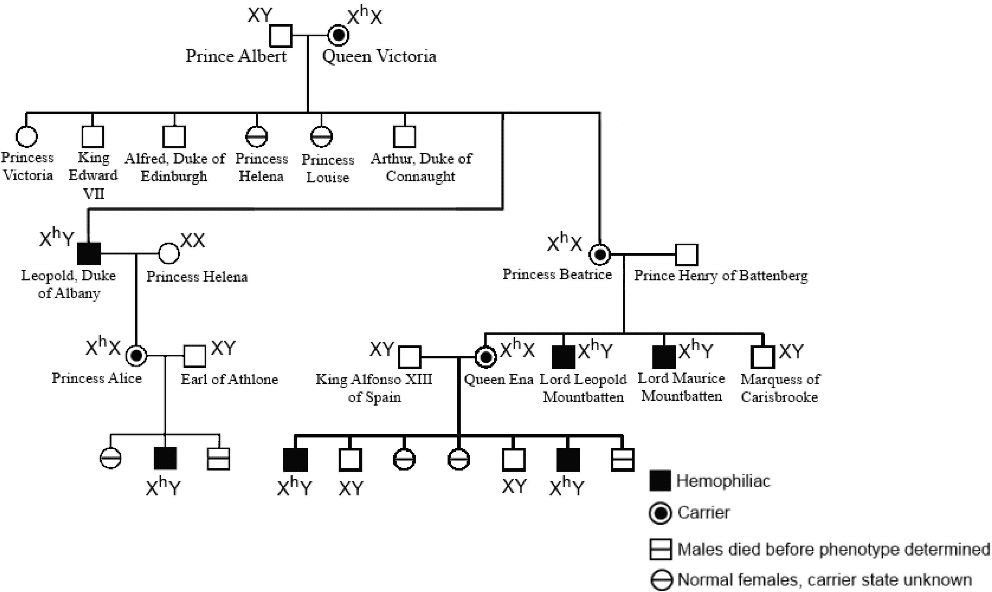
Image credit: CKRobinson, CC BY-SA 4.0, via Wikimedia Commons
Activity
Discourse Debrief activity:
Make connections to the Essential Question:
Accountability (Exit Ticket) The pedigree chart below tracks the inheritance of a hereditary genetic disorder through several generations in a family. Family members who have expressed the disorder are represented by shaded symbols.
5.If Alec and Tracey have another child, is it possible for the child to have the disorder? Explain your response. [2]
It is possible for Alec and Tracey’s next child to have the disorder. Even though neither Alec nor Tracey have the disorder, Alec’s father does, so Alec could be a carrier. Because we do not have information about Tracey’s family pedigree chart, it is possible that she is also a carrier. Therefore, their offspring could potentially inherit the disorder even though neither of their parents has expressed it.
Scoring Award points as follows:
Lesson Objective: Cells are specialized to perform different functions within the body. Errors (such as mutations) that occur during cellular division and differentiation / specialization processes can affect the DNA within a cell. If not corrected by the body, these errors can cause changes in an organism. These changes can be beneficial, neutral, or harmful.
Materials Needed
Prep
What are scholars doing in this lesson?
Do Now
Launch
Activity
Discourse Debrief activity:
Make connections to the Essential Question:
Accountability (Exit Ticket) After studying the link between exposure to the sun’s UV rays and skin cancer, Molly says, “All mutations are so dangerous! I hope I never have one!”
Molly should not be worried about a genetic mutation occurring in her body. In fact, they happen frequently, so Molly’s DNA has likely already experienced many mutations over the course of her life! A mutation is an “error” that occurs when DNA is replicated. This error could mean that individual genes are inserted, eliminated, or changed, and these changes may be beneficial, neutral, or harmful. Not all mutations have serious consequences like cancer, so she should only worry about the ones that are actually harmful.
Scoring Award points as follows:
Note: Scholars may argue either way as long as their claim is clear and defended by relevant evidence from class.
Lesson Objective: Selective breeding is a practice in which a person chooses certain organisms to breed based on their expression of certain traits.
Materials Needed
Prep
What are scholars doing in this lesson?
Do Now
Launch
[Engagement Tip: Allow each group to come up with a name for their farm before the competition begins!]
Activity
Discourse Debrief activity:
Make connections to the Essential Question:
Accountability (Lab Notebook)
Scoring Award points as follows:
Lesson Objective: Genetic engineering is a process in which a person alters the actual DNA of an organism in the hope of producing a certain desired result in that organism.
Materials Needed
Prep
What are scholars doing in this lesson?
Do Now
Launch
Research
Discourse Debrief research:
Make connections to the Essential Question:
Accountability (Lab Notebook)
Scoring Award points as follows:
Lesson Objective: Scholars have the opportunity to demonstrate their mastery of the unit goals! They should be able to articulate several causes of genetic diversity, predict patterns of inheritance and model them mathematically, and compose a robust answer to the unit’s Essential Question.
Materials Needed
Prep
Sample Student Data for Six Genetic Crosses
| Cross # | Phenotypic Frequency | Ratio | Possible Genotypes | Mode of Inheritance | Most Likely Parental Cross |
|---|---|---|---|---|---|
1 |
25 red |
100% |
RR or Rr |
Mendelian |
RR x RR or RR x Rr |
2 |
24 colorless |
100% |
rr |
Mendelian |
rr x rr |
3 |
37 red/12 colorless |
3:1 |
RR/rr |
Mendelian |
Rr x Rr |
4 |
26 yellow |
100% |
YY |
Codominance or Mendelian |
YY x YY |
5 |
30 orange |
100% |
RY |
Incomplete dominance |
RR x YY |
6 |
11 red /20 orange /9 yellow |
1:2:1 |
RR/RY/YY |
Incomplete dominance |
RY x RY |
7 |
25 yellow with red spots |
100% |
RY |
Codominance |
RR x YY |
What are scholars doing in this lesson?
Do Now
Launch
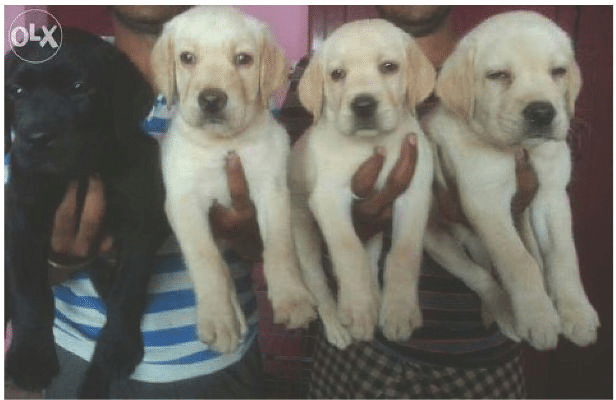
Image credit: Firoz111, CC BY-SA 4.0, via Wikimedia Commons
Activity Adapted from William P. Baker and Cynthia L. Thomas’s “Gummy Bear Genetics,” November 1998
Note: This activity is lengthy and has been split to be completed over two days.
Discourse Debrief activity:
Make broader connections:
Accountability (Exit Ticket) Read the excerpt below about the formation of fraternal twins and then answer the question that follows.
Fraternal Twins
By Donna Krasnewich, M.D., Ph.D.
Fraternal twins are also dizygotic twins. They result from the fertilization of two separate eggs during the same pregnancy. Fraternal twins may be of the same or different sexes. They share half of their genes just like any other siblings. In contrast, twins that result from the fertilization of a single egg that then splits in two are called monozygotic, or identical, twins. Identical twins share all of their genes and are always the same sex.
Fraternal twins are also called dizygotic twins. And the difference between fraternal and identical twins is that fraternal twins derive from two different eggs. Fraternal twins may be the same gender, they may have many of the same characteristics, but they also may be very different from each other and, in fact, share half of their genes, just like their sisters and brothers. It’s important to recognize that the difference between fraternal twins and monozygotic, or identical, twins is that monozygotic twins result from the fertilization of a single egg with a single sperm, and then, during the embryonic development or during the cell splits, those massive eggs split into two individuals, which later develop into two offspring.
Excerpt courtesy of National Human Genome Research Institute
It is possible for twins to look different because they are not genetically identical. The excerpt above states that fraternal twins are each made with their own egg and sperm, and I know that each egg or sperm contains a unique combination of alleles from a parent. For example, the sperm might contain the allele for blond hair, whereas another may contain the allele for brown hair, even if they come from the same father. Thus, siblings inherit unique combinations of traits from their parents, even if they are twins.
Scoring Award points as follows:
Do Now
Launch
Activity
Discourse Debrief activity:
Make broader connections:
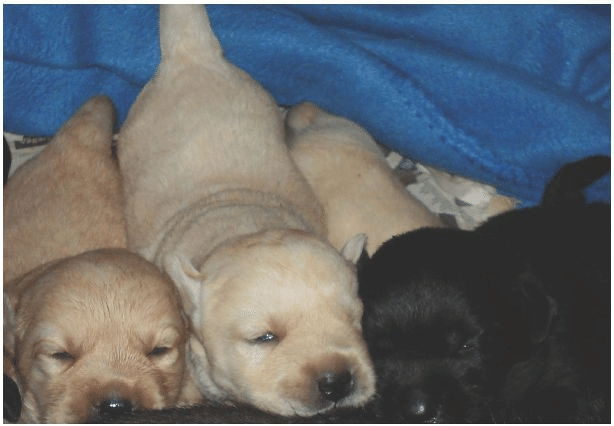
Image credit: Ginsten, CC BY_SA 3.0, via Wikimedia Commons
•Explain that the parents had another litter of puppies. Have scholars revisit the class’s original hypotheses to see if they still agree, and share their takeaways.
Accountability (Exit Ticket)
1.Compose an answer to the unit’s Essential Question: Do I have more in common with my friends or my family? Include a detailed explanation with at least three pieces of evidence from the unit.
To decide whether one has more in common with friends or relatives, they must first decide what “in common” means to them. Ultimately, I’d argue you have more in common with your family because of your genetic connectedness.
If you’re talking about your hobbies, your taste in music, or your fashion sense, it’s safe to assume that you have more in common with your friends than your family. Members of a family usually span a wide range of ages and come from several different generations. It’s unlikely they’re all listening to the same songs or wearing the same style of clothing.
However, if you define “in common” more scientifically, you might have a lot more in common with your parents, aunts and uncles, and siblings than you realize. When you are born, you already come with thousands of traits encoded into your DNA. Before your friends ever come into the picture, a lot of what makes you “you” is already determined! Maybe you got your dad’s eyes or your mom’s nose, or the same freckles as your grandmother (although they seemed to “skip a generation”). This is all because of your genes.
When a new human (or other organism created through sexual reproduction) forms from male and female sex cells, it inherits alleles for each gene from both parents. These alleles make up chromosomes that code for everything from skin color to earlobe shape. In addition to physical characteristics, offspring can inherit mental traits and even some diseases! Because of these patterns of inheritance, you are much more genetically similar to your parents or siblings than to any of your friends. Thus, you have more in common with them, even if it doesn’t always seem that way….
Scoring Award points as follows:
Vocabulary List
resources
Access a wide array of articles, webinars, and more, designed to help you help children reach their potential.

ES PBL Grade 2: Brooklyn Bridge
Educator
Curriculum
Elementary School
2nd
PBL
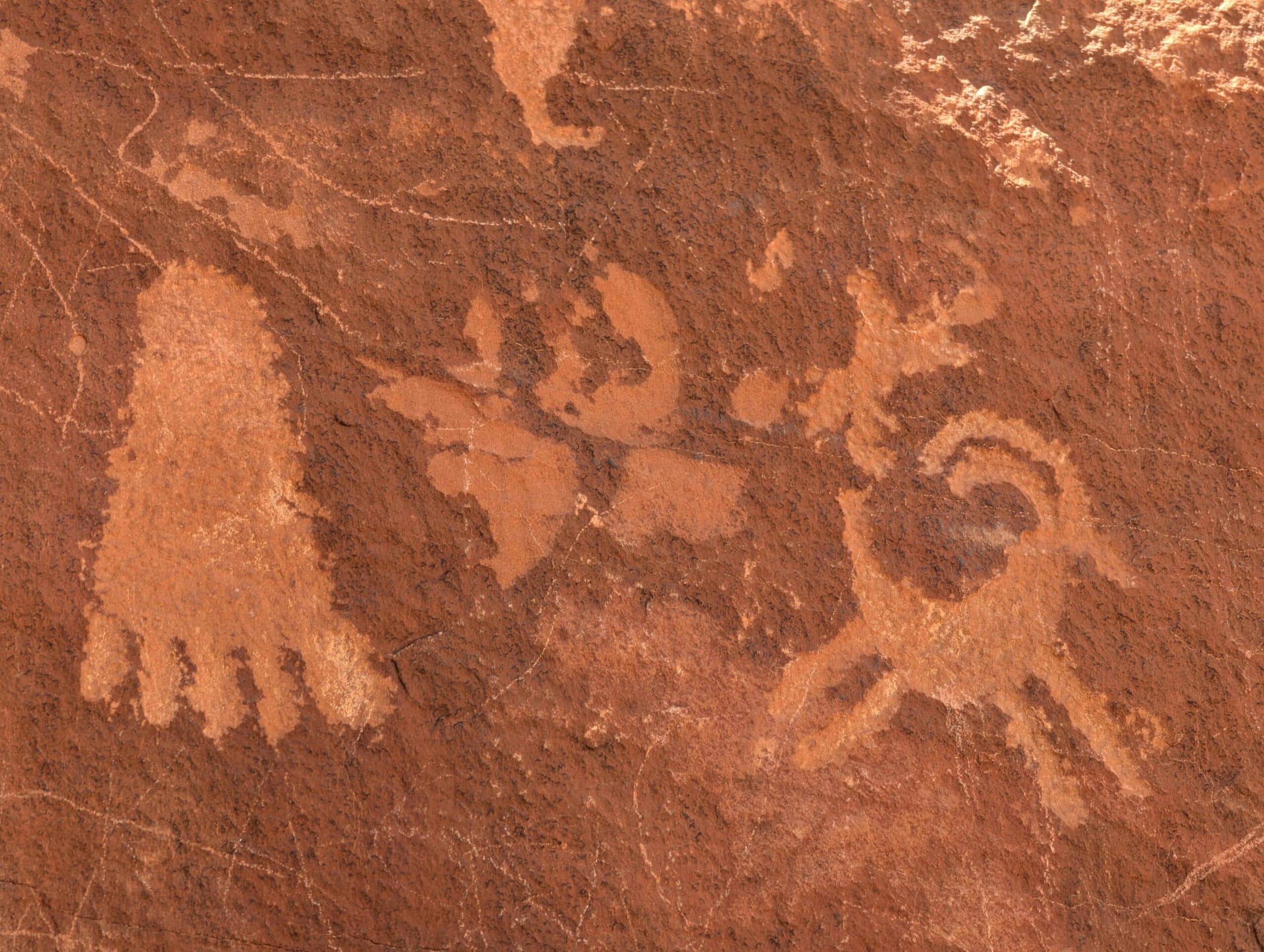
ES PBL Grade 3: Iroquois and Lenape
Educator
Curriculum
Elementary School
3rd
PBL
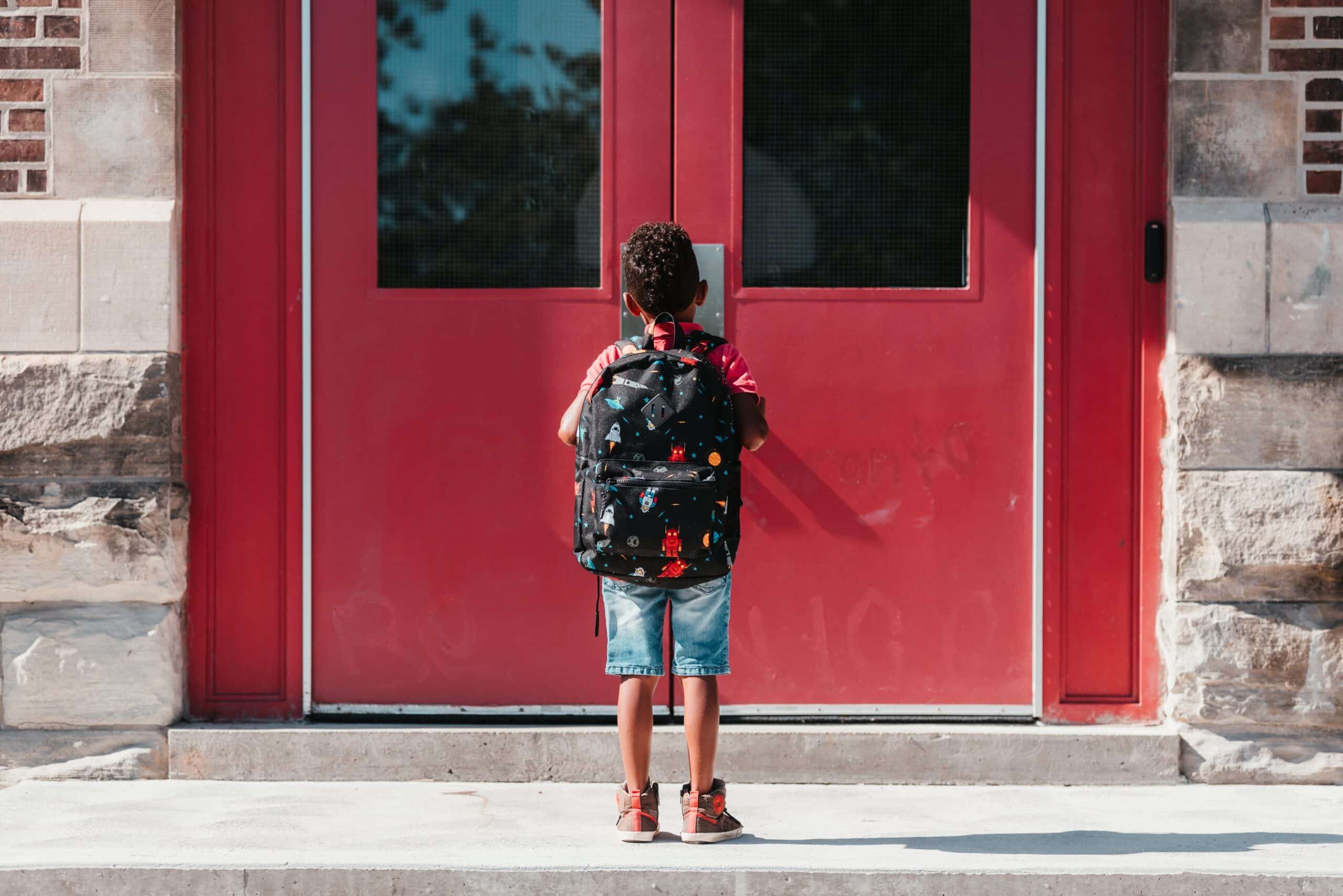
Grade 1: PBL School – How It Works!
Educator
Curriculum
Elementary School
1st
PBL
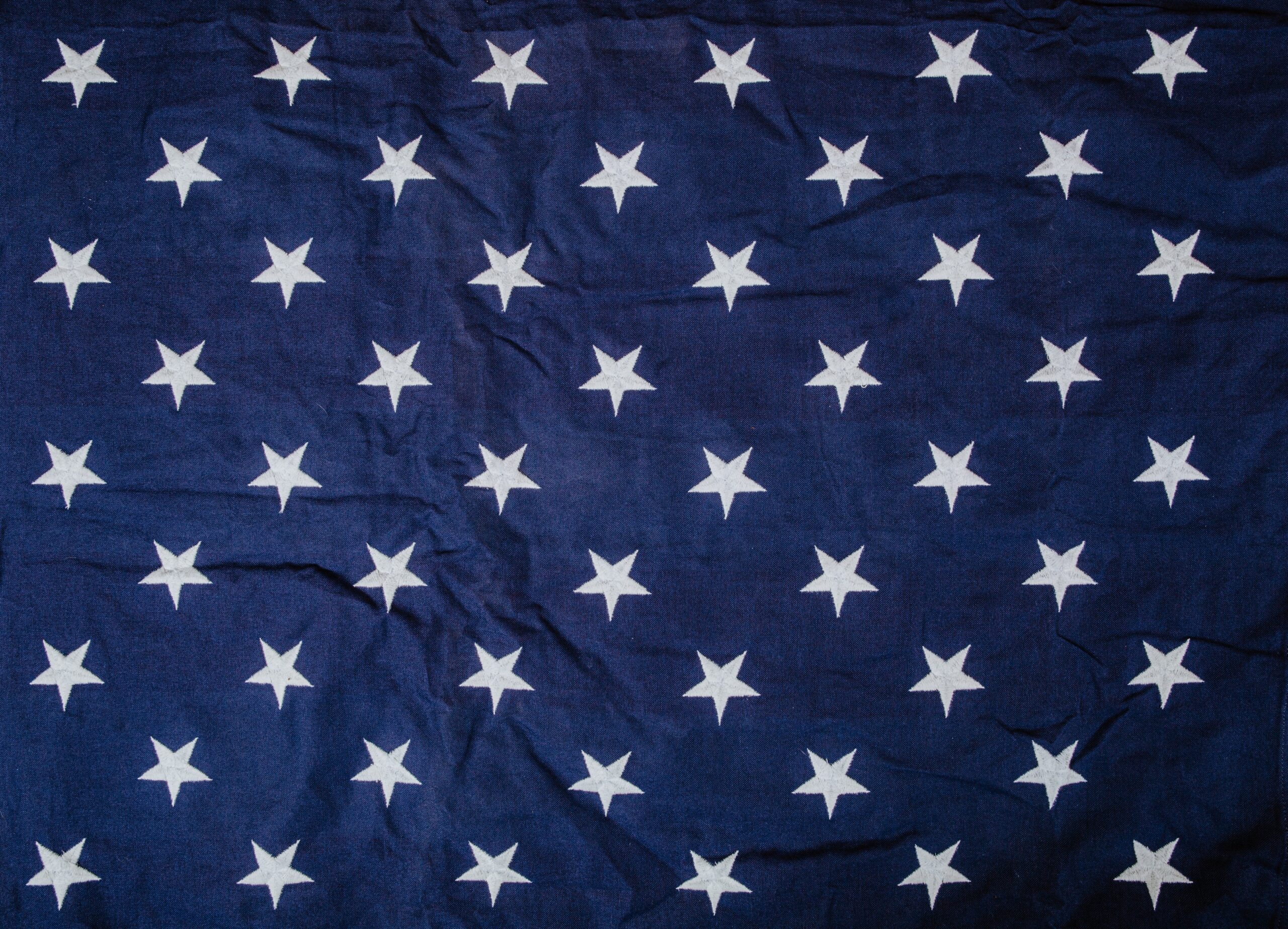
Grade 4: PBL A Nation is Born
Educator
Curriculum
Elementary School
4th
PBL
NEWSLETTER
"*" indicates required fields
